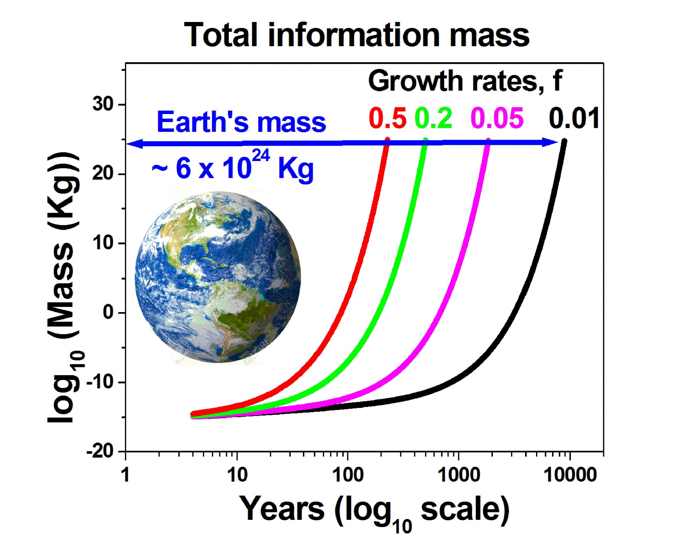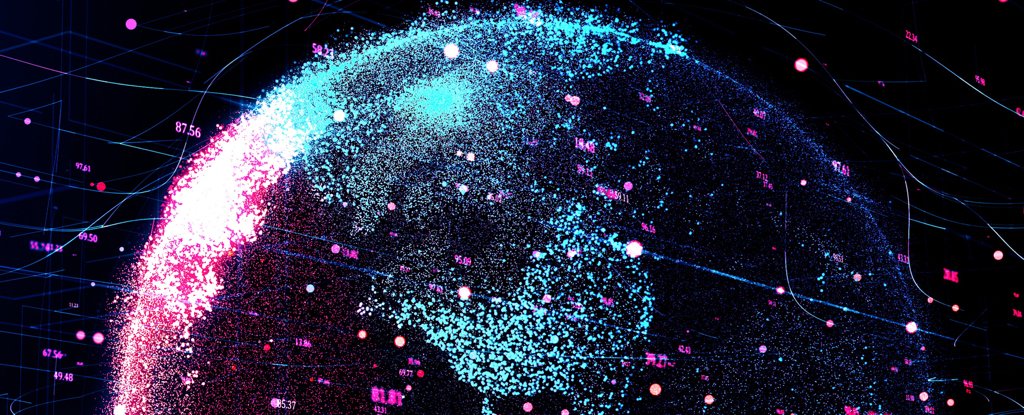Products You May Like
The world could be headed for an ‘information catastrophe’ as the rate of production of digital bits continues to accelerate with no sign of stopping, new research suggests.
In a new study – one firmly positioned in the more abstract quarters of theoretical physics, it must be said – researcher Melvin Vopson from the University of Portsmouth in the UK predicts that our ever-increasing virtual stockpiles of digital information could have dramatic, unforeseen consequences for matter on the planet.
“We are literally changing the planet bit by bit, and it is an invisible crisis,” Vopson says.
To understand Vopson’s newest ideas, it’s worth considering a theoretical construct he proposed last year, called the mass-energy-information equivalence principle.
In that work, Vopson took inspiration from research by German-American physicist Rolf Landauer in the 1960s, which held that information has a physical nature, due to thermodynamic constraints.
 Projected increases in digital information mass in the future. (Vopson, AIP Advances, 2020)
Projected increases in digital information mass in the future. (Vopson, AIP Advances, 2020)
Building upon those ideas, Vopson hypothesised a digital bit of information was not just physical, as Landauer suggested, but something that has a finite and quantifiable mass while it stores information.
In Vopson’s thinking and theoretical calculations, the mass of a data storage device would increase by a small amount when loaded up with digital information, relative to its mass in an erased state. This theoretical increase in mass would be incredibly tiny, Vopson says, but still significant and measurable.
That said, Vopson’s idea – the mass-energy-information equivalence principle – has not yet been experimentally verified at this time.
Not to be discouraged, the researcher has now published a new paper, examining some of the hypothetical future consequences if his theoretical principle turns out to be true – and the predictions make for some mind-boggling reading.
First up, Vopson considers IBM estimations that approximately 2.5 quintillion bytes of digital data are produced every day on Earth, which amounts to about ~1021 digital bits of information annually.
If the amount of digital content we make increases by 20 percent annually, Vopson calculates that within about 350 years or so, the number of digital bits being produced will exceed the number of all atoms on Earth.
Even before we get to that point, though, the power consumption required to sustain all that digital information production would be more than the planet currently provides, Vopson says. But that’s not all.
If we factor in the mass-energy-information equivalence principle – that old bugbear – this gargantuan amount of digital information will have significant implications in terms of mass, not just in terms of energy.
“Assuming a conservative annual growth of digital content creation of 1 percent… we estimate that it will take around ~3,150 years to produce the first cumulative 1 kg of digital information mass on the planet and it will take ~8,800 years to convert half of the planet’s mass into digital information mass,” Vopson explains in his paper.
“When we input larger growth rates of 5 percent, 20 percent, and 50 percent, respectively, these numbers become extreme.”
Extreme is one way of putting it. At 50 percent growth annually, digital content would account for half of the entire planet’s mass within just 225 years.
Of course, all these theoretical predictions have to be taken with a hefty grain of salt, because the abstract concepts being explored here wouldn’t necessarily correspond exactly to the real world in the same way that the equations suggest.
There are a huge number of uncertainties and unknowns, not the least of which is the unproven mass-energy-information equivalence principle itself.
Nonetheless, it’s some fascinating thinking, and Vopson hopes his ideas will stimulate further theoretical and experimental research that can get us closer to answering some of these very big questions.
“Since both special relativity and Landauer’s principle have been proven correct, it is highly probable that the new principle will also be proven correct,” Vopson told Inverse.
“Although it is currently just a theory”.
The findings are reported in AIP Advances.
